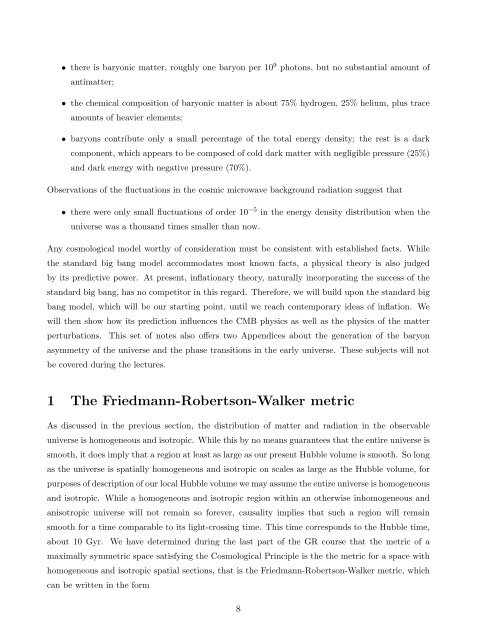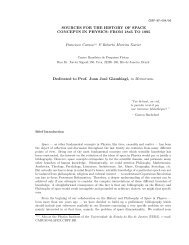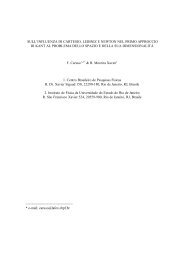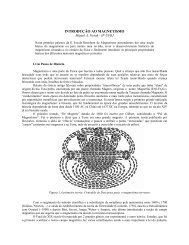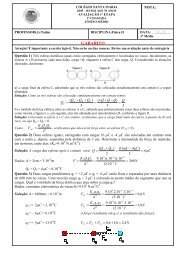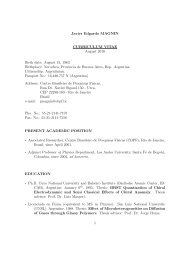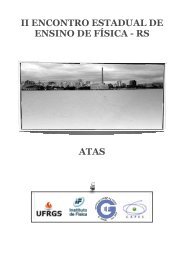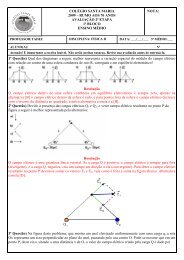Primordial non-Gaussianity in the cosmological perturbations - CBPF
Primordial non-Gaussianity in the cosmological perturbations - CBPF
Primordial non-Gaussianity in the cosmological perturbations - CBPF
Create successful ePaper yourself
Turn your PDF publications into a flip-book with our unique Google optimized e-Paper software.
• <strong>the</strong>re is baryonic matter, roughly one baryon per 10 9 photons, but no substantial amount of<br />
antimatter;<br />
• <strong>the</strong> chemical composition of baryonic matter is about 75% hydrogen, 25% helium, plus trace<br />
amounts of heavier elements;<br />
• baryons contribute only a small percentage of <strong>the</strong> total energy density; <strong>the</strong> rest is a dark<br />
component, which appears to be composed of cold dark matter with negligible pressure (25%)<br />
and dark energy with negative pressure (70%).<br />
Observations of <strong>the</strong> fluctuations <strong>in</strong> <strong>the</strong> cosmic microwave background radiation suggest that<br />
• <strong>the</strong>re were only small fluctuations of order 10 −5 <strong>in</strong> <strong>the</strong> energy density distribution when <strong>the</strong><br />
universe was a thousand times smaller than now.<br />
Any <strong>cosmological</strong> model worthy of consideration must be consistent with established facts. While<br />
<strong>the</strong> standard big bang model accommodates most known facts, a physical <strong>the</strong>ory is also judged<br />
by its predictive power. At present, <strong>in</strong>flationary <strong>the</strong>ory, naturally <strong>in</strong>corporat<strong>in</strong>g <strong>the</strong> success of <strong>the</strong><br />
standard big bang, has no competitor <strong>in</strong> this regard. Therefore, we will build upon <strong>the</strong> standard big<br />
bang model, which will be our start<strong>in</strong>g po<strong>in</strong>t, until we reach contemporary ideas of <strong>in</strong>flation. We<br />
will <strong>the</strong>n show how its prediction <strong>in</strong>fluences <strong>the</strong> CMB physics as well as <strong>the</strong> physics of <strong>the</strong> matter<br />
<strong>perturbations</strong>. This set of notes also offers two Appendices about <strong>the</strong> generation of <strong>the</strong> baryon<br />
asymmetry of <strong>the</strong> universe and <strong>the</strong> phase transitions <strong>in</strong> <strong>the</strong> early universe. These subjects will not<br />
be covered dur<strong>in</strong>g <strong>the</strong> lectures.<br />
1 The Friedmann-Robertson-Walker metric<br />
As discussed <strong>in</strong> <strong>the</strong> previous section, <strong>the</strong> distribution of matter and radiation <strong>in</strong> <strong>the</strong> observable<br />
universe is homogeneous and isotropic. While this by no means guarantees that <strong>the</strong> entire universe is<br />
smooth, it does imply that a region at least as large as our present Hubble volume is smooth. So long<br />
as <strong>the</strong> universe is spatially homogeneous and isotropic on scales as large as <strong>the</strong> Hubble volume, for<br />
purposes of description of our local Hubble volume we may assume <strong>the</strong> entire universe is homogeneous<br />
and isotropic. While a homogeneous and isotropic region with<strong>in</strong> an o<strong>the</strong>rwise <strong>in</strong>homogeneous and<br />
anisotropic universe will not rema<strong>in</strong> so forever, causality implies that such a region will rema<strong>in</strong><br />
smooth for a time comparable to its light-cross<strong>in</strong>g time. This time corresponds to <strong>the</strong> Hubble time,<br />
about 10 Gyr. We have determ<strong>in</strong>ed dur<strong>in</strong>g <strong>the</strong> last part of <strong>the</strong> GR course that <strong>the</strong> metric of a<br />
maximally symmetric space satisfy<strong>in</strong>g <strong>the</strong> Cosmological Pr<strong>in</strong>ciple is <strong>the</strong> <strong>the</strong> metric for a space with<br />
homogeneous and isotropic spatial sections, that is <strong>the</strong> Friedmann-Robertson-Walker metric, which<br />
can be written <strong>in</strong> <strong>the</strong> form<br />
8


